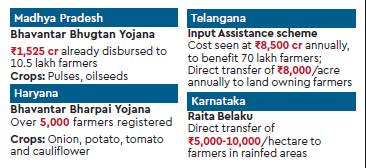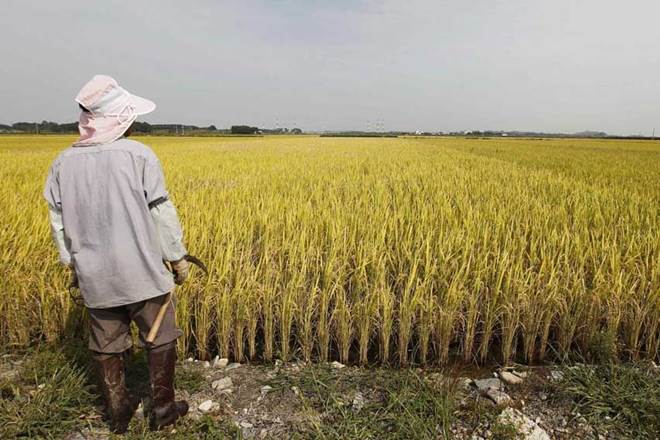At least five state governments are rolling out innovative schemes to help farmers realise remunerative returns, even as the Centre has started working on a plan to ensure that farmers get minimum support prices for their produce, whether or not the items are procured by the designated agencies. The states have estimated the expenditures on these schemes to be much lower than what such largesse, if implemented in earnest, could potentially cost. FE had estimated, assuming a 20% differential between the market price and MSP and the crop quantities that could potentially need such support, that if the current MSPs are to be ensured for all the relevant crops, the cost to the exchequer could be around Rs 80,000 crore. The Centre has estimated that its scheme — the contours of which are being finalised by the NITI Aayog — could cost it Rs 15,000 crore annually. Additionally, states are expected to pitch in too, although adoption of the scheme is optional for them. Madhya Pradesh was the first to launch a price support scheme for farmers following the farmers’ agitation and police firing in Mandsaur: in October last year, the state government rolled out the Bhavantar Bhugtan Yojana (price differential payment scheme) for maize, soybean, urad, moong, groundnut and sesame in the kharif season and winter crops namely chana, masur, mustard and onion.

The state government has already distributed about Rs 1,525 crore under the scheme to over 10.5 lakh farmers since its launch. Under the scheme, an amount equal to the difference between MSP and the market rate of a crop is transferred to the beneficiary bank accounts, when market prices fall below the benchmark rates. On the lines of MP’s scheme, Haryana launched a price differential payment scheme called Bhavantar Bharpai Yojana in January, for the potato and tomato crops which will be harvested in the state from this month-end. The state has fixed a base price of Rs 4/kg for these two crops in the absence of any MSP mechanism at the all-India level for these crops. According to the state’s marketing board, more than 5,000 farmers have registered under the scheme so far. The scheme for two other vegetable crops – onion and cauliflower – will be launched in October and their benchmark rate has been fixed at Rs 5/kg. However, the rate may be revisited before the sowing season. “If farmers have to sell these vegetables below the fixed base price, the government will pay the remaining amount to compensate the farmers. More crops may be added to the list depending on the market rates,” an state government official said. On its part, Telangana government will transfer Rs 4,000 per acre to each farmer during the first fortnight of May as input assistance ahead of the kharif sowing season and an equal amount will be given before rabi planting begins in October. Though it is not an income guarantee programme, it could help farmers to partially recover the real expenditure of cultivation. The total annual budget for the scheme is seen at Rs 8,500 crore, with 70 lakh land-owning farmers irrespective of rich or poor, potentially benefiting.
Poll-bound Karnataka has allocated Rs 5,849 crore for agriculture in the budget for 2018-19 and kept 20% of the total budget for agriculture and rural development. It has announced launch of Raita Belaku scheme to provide guaranteed income to farmers in rainfed areas. Although the details are yet to be worked out, the assistance could be between Rs 5,000 and Rs 10,000 per hectare per year. Besides, loans for farmers are also been disbursed at subsidised interest rate of 3%. Maharashtra is said to be considering to launch a price support scheme, but the plan has been delayed since the state is waiting for the roll out of the Centre’s Market Assurance Scheme (MAS). According to the concept paper of the MAS, the liability of the Central government will arise only if prices fall below MSP, and such obligation is limited to a maximum of 50% (for north-east and hilly states) and 40% (for other states) of the MSP. The Centre has found that on recent procurement of pulses and oilseeds, losses by its designated agencies range between 25-40%. Finance Minister Arun Jaitley had announced in the latest budget that Niti Aayog would put in place a fool-proof mechanism so that farmers get adequate price for their produce. “It is essential that if price of the agriculture produce market is less than MSP, then in that case government should purchase either at MSP or work in a manner to provide MSP for the farmers through some other mechanism.
Prabhu Datta Mishra

